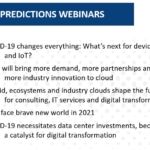COVID-19 changes everything: What’s next for devices and IoT?
In pandemic recovery, IoT will contribute to organizations’ resilience, while PC sales will suffer from saturation
The COVID-19 outbreak has had two effects on pre-existing trends: In many cases, such as the migration to remote working, it has accelerated them, and in others, like the deployment of voice solutions in workplace environments, it has interrupted them. Where trends are accelerated, we can expect a slowdown or temporary rebound as the economy recovers from the impacts of the pandemic, followed by a resumption of the trend. Where trends are interrupted, resumption will often be delayed until later in the recovery, when there is less uncertainty.
Under these circumstances, it is worthwhile to look back at last year’s predictions:
- There will be less talk of IoT, as it will be increasingly viewed as one technique among many for delivering digital transformation.
This trend was accelerated by the pandemic, as organizations focused on operating in the crisis and preparing for greater uncertainty during and following the recovery. In a sense, once IoT was better understood by customer organizations, including IT, operational technology (OT) and business management, it no longer required special attention. The focus shifted from the enabling technology, IoT, to the problems to be solved using all techniques including IoT.
- AI in IoT will increasingly be encapsulated in specific functions like recognition and detection.
This trend was also accelerated by the pandemic, as organizations focused on point solutions that included IoT and strategic solutions that incorporated data from all sources, including from IoT. At the edge, AI is aimed at improving operations by increasing efficiency and reducing errors as well as recognizing things like anomalies and patterns that imply a need for service. IoT-generated data contributes to AI-enabled business analysis, but that is as part of a larger body of data, including data from other sources, and is typically done either in the cloud or in on-premises data centers.
- Conversational user interfaces, based on voice or typed communication, will play an increasing role in business solutions.
Many natural language processing (NLP) projects have been deferred or slowed due to pandemic constraints as well as organizations diverting attention and dollars to more pressing needs or to husbanding resources for a more uncertain future. A minority of NLP projects, especially ones already in use, have been accelerated because they reduce dependency on human operators. While conversational solutions remain in the digital transformation tool kit, TBR believes NLP will remain a lower priority for the first stages of recovery, as organizations look to solutions that increase resilience and transparency.
This focus on digital transformation for resilience and transparency, giving organizations the flexibility to adapt to changing conditions in the pandemic recovery and economic unpredictability, is, TBR believes, the next phase in the evolution of commercial IoT. At the same time, the PC industry faces a saturation-driven reduction in demand following a pandemic-driven surge in 2020.
2021 Devices & Commercial IoT Predictions
- The emergence of the chief data officer role will increase organizational clarity, accelerating IoT adoption
- Packaged solutions and components will become more important
- Despite enjoying an increase in TAM, PC vendors suffer from market saturation, a weak global economy and demand for resale units
Technology Business Research 2021 Predictions is a special series examining market trends and business changes in key markets. Covered segments include cloud & software, telecom, devices & commercial IoT, data center, and services & digital.


Leave a Reply
Want to join the discussion?Feel free to contribute!